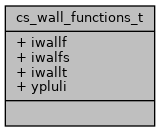wall functions descriptor.
More...
#include <cs_wall_functions.h>
wall functions descriptor.
Members of this wall functions descriptor are publicly accessible, to allow for concise syntax, as it is expected to be used in many places.
◆ iwalfs
wall functions for scalar
- 0: three layers (Arpaci and Larsen) or two layers (Prandtl-Taylor) for Prandtl number smaller than 0.1
- 1: consistant with the 2 scales wall function for velocity using Van Driest mixing length
◆ iwallf
Indicates the type of wall function used for the velocity boundary conditions on a frictional wall.
- 0: no wall functions
- 1: one scale of friction velocities (power law)
- 2: one scale of friction velocities (log law)
- 3: two scales of friction velocities (log law)
- 4: two scales of friction velocities (log law) (scalable wall functions)
- 5: two scales of friction velocities (mixing length based on V. Driest analysis) iwallf is initialised to 2 for iturb = 10, 40, 41 or 70 (mixing length, LES and Spalart Allmaras).
iwallf is initialised to 0 for iturb = 0, 32, 50 or 51
iwallf is initialised to 3 for iturb = 20, 21, 30, 31 or 60 (  ,
,  LRR,
LRR,  SSG and
SSG and  SST models).
SST models).
The v2f model (iturb=50) is not designed to use wall functions (the mesh must be low Reynolds).
The value iwallf = 3 is not compatible with iturb=0, 10, 40 or 41 (laminar, mixing length and LES).
Concerning the  and
and  models, the two-scales model is usually at least as satisfactory as the one-scale model.
models, the two-scales model is usually at least as satisfactory as the one-scale model.
The scalable wall function allows to virtually shift the wall when necessary in order to be always in a logarithmic layer. It is used to make up for the problems related to the use of High-Reynolds models on very refined meshes.
Useful if iturb is different from 50.
◆ iwallt
exchange coefficient correlation
- 0: not use by default
- 1: exchange coefficient computed with a correlation
◆ ypluli
limit value of  for the viscous sublayer
for the viscous sublayer
ypluli depends on the chosen wall function: it is initialized to 10.88 for the scalable wall function (iwallf=4), otherwise it is initialized to  . In LES, ypluli is taken by default to be 10.88. Always useful.
. In LES, ypluli is taken by default to be 10.88. Always useful.
The documentation for this struct was generated from the following files:

 ,
,  LRR,
LRR,  SSG and
SSG and  SST models).
SST models). and
and  models, the two-scales model is usually at least as satisfactory as the one-scale model.
models, the two-scales model is usually at least as satisfactory as the one-scale model. 1.8.16
1.8.16